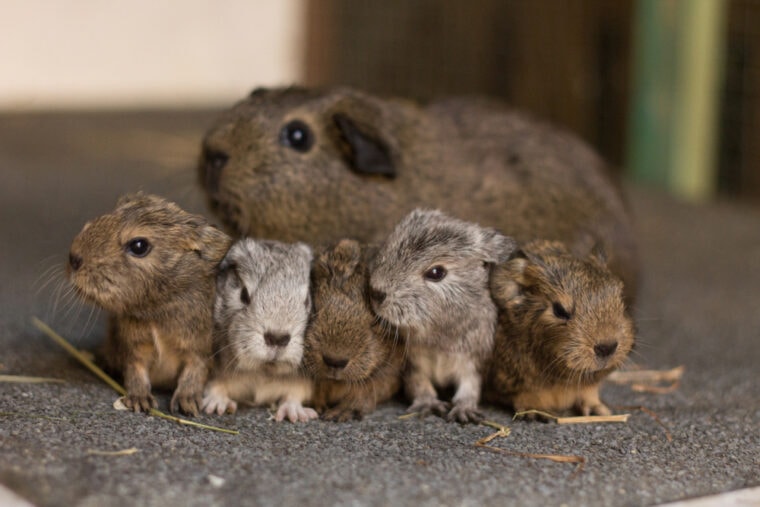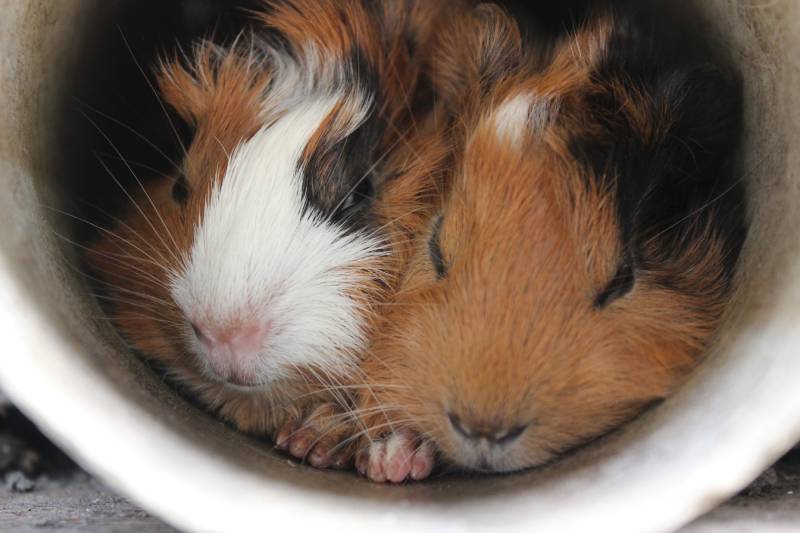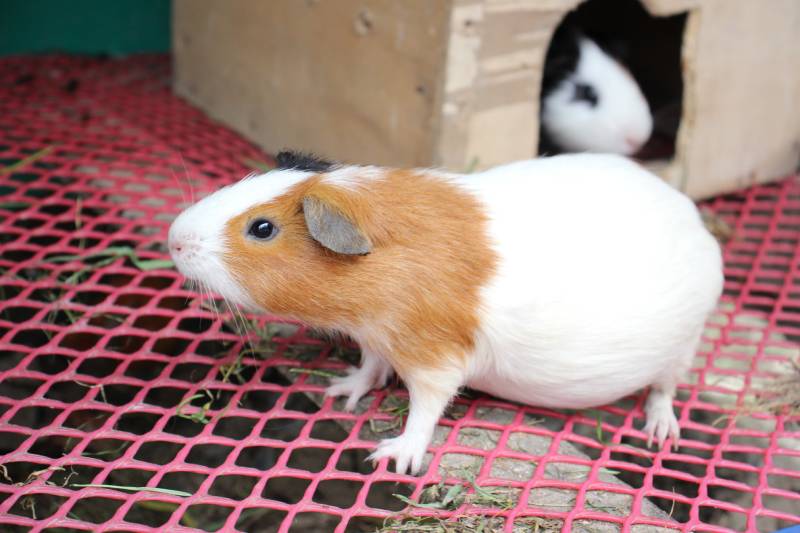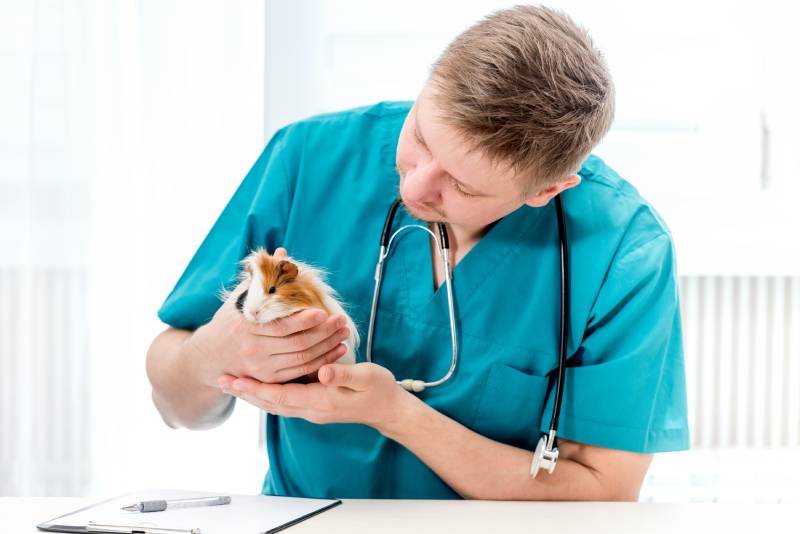
Click to Skip Ahead
A female guinea pig is known as a sow, whereas a male guinea pig is called a boar. Like most species of rodents, guinea pigs are very prolific and housing males and females together will almost certainly lead to breeding. However, the risks associated with breeding these animals (particularly for the female) makes it difficult to justify breeding these animals without the appropriate expertise.
In this article, we will discuss the basics about guinea pig reproduction.
For animal welfare, veterinarians do not recommend or encourage breeding guinea pigs. Breeding guinea pigs almost always reduces the lifespan of the female, and finding responsible owners for young guinea pigs can be a daunting task. Guinea pigs can indiscriminately breed with their offspring, siblings, or parents. Breeding these animals is a task best left to an experienced breeder. For these reasons, it is best to house male and female guinea pigs separately.
Spaying or neutering a guinea pig can be done by vets who are experienced with small mammals.
The information in this article is for informational purposes only. At PetKeen, we do not encourage breeding guinea pigs.
The Best Age to Breed Guinea Pigs
Guinea pigs become sexually mature at a young age 1. Females are sexually mature by as young as 4-8 weeks, whereas males are sexually mature by 8 to 12 weeks of age. Although guinea pigs are ready to mate at 8 weeks, it doesn’t mean they should.
Females are usually bred before they reach 8 months of age. As a sow reaches adulthood, she undergoes a normal stiffening of the pubic symphysis (a joint of tough fibrous cartilage between the 2 pubic bones of the pelvis). Breeding a female guinea pig for the first time after she reaches 8 months of age is dangerous because of the a stiffened pubic symphysis without a prior pregnancy will likely lead to a sow who may not be able to deliver their young normally.
Male guinea pigs are polyamorous, so they can impregnate more than one sow as the sows come into heat. To avoid this, it is best to keep males and females separated. For mixed sex colonies of guinea pigs, it is usually the males that are neutered, however, guinea pigs in general (regardless of their sex) do not handle anesthesia well and therefore, the easiest way of avoiding unwanted litters is to keep males and females separated.
Guinea Pigs Heat and Gestation Cycle
Female guinea pigs go into heat every 16 days starting from sexual maturity, which lasts about 12 hours 2. The trigger for a heat cycle is currently unknown and a sexually mature female may start cycling at any point. However, it is postulated that they tend to cycle more readily around springtime.
There is no evidence that the male guinea pig goes into heat, though their behavior can change dramatically after they realize a female has shown signs of being in heat.
Be careful when having multiple unfixed guinea pigs in the same cage. If an unfixed male knows a sow is in heat, they’ll fight other males as part of courtship to determine who will impregnate the female. The best way to avoid this aggressive behavior is to pick a female and a male and put them together in a separate cage until your sow is pregnant.
So, how do guinea pigs mate? A female will go into heat, and the chosen male will cuddle, groom, and vocalize with the female guinea. Once a bond has been formed, the male will mount the female and impregnate her. Females are often receptive at night, and therefore, these amorous activities can go unnoticed. After successful pairing and impregnation, you can expect your female guinea pig to stay pregnant for 59 to 72 days.

While it’s unclear whether females and males shall be separated during the pregnancy, watching your pregnant sow for signs of distress is a good idea. However, keeping all males away from the sow and her babies is best once your pregnant sow has given birth.
Female guinea pigs begin a new estrous cycle shortly after they give birth. It is not unusual for a female with newborns to conceive shortly after she gives birth.
Signs a Sow Is Pregnant
There are few signs of a sow pregnancy, though it’s a good chance a pregnancy was successful if she had gone into heat and was paired with a sexually mature male. Noticeable signs include weight gain and a larger abdomen. However, physical signs of pregnancy won’t show until about 2 to 3 weeks.
If an unaltered male and female spent some time together in a cage, there’s a good chance that your female is pregnant. If you suspect your guinea pig is pregnant, taking her to see a vet immediately is a good idea. Pregnancy can be misdiagnosed at home with cysts.
Your vet can tell if your female guinea pig is pregnant and will advise you on what to do next and any complications to be aware of.

Pregnancy Complications
The most common pregnancy complication in guinea pigs is pregnancy toxemia (pregnancy ketosis). Pregnancy ketosis is scary because it occurs near the last few days of pregnancy.
Immediately seek veterinary care if you suspect that your female guinea pig is experiencing pregnancy ketosis.
The best way to avoid these complications is to ensure you’ve paired a healthy sow and boar for a planned pregnancy. Maintaining a healthy diet for the sow and decreasing as much stress as possible throughout her pregnancy, alongside veterinary care are also key in avoiding pregnancy complications.
If you suspect your sow has any difficulty or change in behavior throughout her pregnancy, take her to see a vet immediately.

How to Care for a Pregnant Guinea Pig
Pregnant guinea pigs have all the same requirements as non-pregnant guinea pigs, except they’ll need more of everything while they care for their fetuses. Since guinea pigs are social animals who feel most comfortable in groups, it’s a good idea to have at least one other cage mate with them (preferably another female). However, if having another female as a cage-mate, a male is another option, though you’ll need to pay extra attention in case fights or aggression breaks out.
By the last 2 weeks of your guinea pig’s pregnancy, you’ll want to separate her from her cage mates so she can prepare for labor undisturbed. During the last 2 weeks, you may want to check on her through the night to ensure everything is okay. Call your vet when you suspect she’ll be giving birth. Sometimes, it’s best if she delivers her babies at the pet hospital.
How Many Babies Can Sows Have on Average?
Pregnant guinea pigs can have up to eight pups, though first-timers are likely to have three to four. It’s best not to put the father or any male in the cage with newborn pups and female guinea mothers, as it’s very easy to become pregnant again hours after delivery.

How to Care for Newborn Guinea Pigs
Newborn guinea pigs are considered precocial. This means that they are highly independent at birth. They are born with hair, are able to see, and can run. They will nurse from their mother but can nibble on solids when they are as young as 2 days old. They should be allowed to nurse from their mother for a period of about 3 weeks. They can be weaned when they weigh around 6 ounces (170 grams).
You can start handling pups starting about 2 weeks of age. However, the sow must trust you; otherwise, she may abandon her newbies. Remember, sexual maturation age reaches as early as 8 weeks, so it’s best to get your male and female guinea pigs separated as they mature to avoid inbreeding and unwanted litters.
Final Words
Breeding guinea pigs takes time, patience, in-depth knowledge, and planning to ensure everything goes smoothly. If you’re planning to breed your guinea pigs, keep note of how old your guinea pigs are. If you try to breed them for the first time too early or too late after sexual maturity, the chance of complications increases.
Guinea pigs are social animals who need cage mates and socialization throughout their 8 years of life. It’s best not to breed guinea pigs if you’re unwilling to meet their daily needs and create positive routines, for risk of bringing them to a shelter.
In any case, guinea pigs are adorable at any age and thrive in packs.
Featured Image Credit: Joline Greim, Shutterstock








